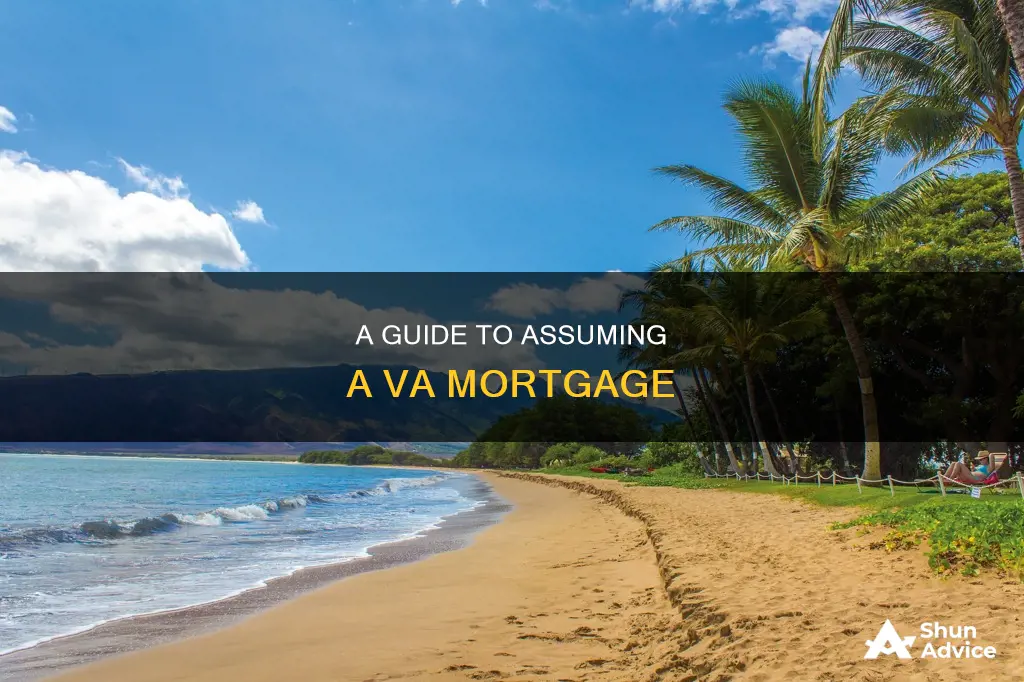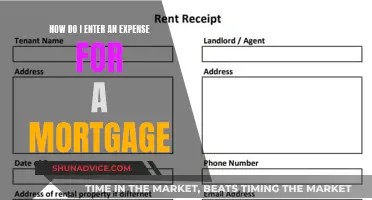
Assuming a VA mortgage is a process where a buyer takes over the terms of an existing VA loan, including the interest rate and remaining loan balance. This allows the buyer to avoid the traditional mortgage process and can result in cost savings due to lower interest rates associated with VA loans. To assume a VA loan, the buyer must meet certain qualifications, including financial and credit score requirements, and the assumption must be approved by the lender and potentially the VA. It's important to note that not all loans are assumable, and there may be fees associated with assuming a VA mortgage. This process can provide benefits for both sellers and buyers, but there are also risks and considerations that should be weighed before proceeding.
| Characteristics | Values |
|---|---|
| Definition | A VA loan assumption is a method to buy a home by taking over someone else’s existing VA mortgage. |
| Who can assume? | Anyone who meets the lender’s financial qualifications can assume a VA loan. This means you don’t have to be a veteran or currently serving in the military to take over an existing VA mortgage. |
| Interest rate | The buyer keeps the same interest rate as the previous homeowner. |
| Monthly payment | The buyer keeps the same monthly payment as the previous homeowner. |
| Loan balance | The new borrower takes on the responsibility for the remaining loan balance and agrees to make all future payments. |
| Lender requirements | Lenders typically have requirements such as minimum credit score and income levels that must be met. To assume a VA loan, the borrower taking over the loan must meet certain qualifications. |
| Fees | Assuming a loan typically comes with a funding fee—usually around 0.5% of the total loan amount. There may also be a nominal processing fee to the lender for their work on the assumption. |
| Benefits | An assumption means you can take advantage of the low rate a homebuyer locked down months or even years prior, when the housing market looked a lot different. |
| Drawbacks | Homeowners want to make sure they capture whatever equity they've built in the property, otherwise there's no benefit to allowing for an assumption. |
| Entitlement | If the person assuming your loan is a veteran with sufficient VA loan entitlement, then you can ask them to formally substitute their entitlement for yours on that mortgage. Otherwise, the entitlement you used to purchase the home will remain tied up there until the loan is fully repaid. |
What You'll Learn

Anyone can assume a VA loan
For buyers, the biggest advantage of assuming a VA loan is the potential cost savings. Buyers can take advantage of the low interest rate secured by the original borrower when market conditions were more favourable. This can result in significantly lower monthly payments, making housing more affordable. Additionally, VA loan assumptions come with fewer costs and fees compared to a traditional purchase loan, as most closing costs are not applicable. However, buyers should be prepared to pay the funding fee of 0.5% of the loan balance, which goes directly to the VA to support the loan program. Buyers might also choose to pay for an appraisal, although it is not required.
On the other hand, sellers need to carefully consider their VA loan entitlement when allowing an assumption. If the buyer is a veteran with sufficient VA loan entitlement, the seller can request a formal substitution of entitlements. Failing to do so can limit the seller's ability to reuse their VA loan benefit in the future. Sellers also need to ensure that the buyer can cover their equity in the property, usually through a cash payment, to make the assumption worthwhile.
To assume a VA loan, buyers must meet certain qualifications set by the lender, including credit score, income stability, debt-to-income ratio, and cash reserves. The specific requirements may vary depending on the lender, so it is important to consult with a loan officer and a lawyer to ensure a smooth process.
Applying for a HARP Mortgage: A Step-by-Step Guide
You may want to see also

Pros and cons of VA loan assumptions
VA loan assumptions, which are available to both veterans and non-veterans, come with several benefits and drawbacks.
Pros
VA loan assumptions allow a homebuyer to take over an existing VA loan, including its interest rate and remaining balance. This can be especially valuable in a high-rate environment, potentially offering homebuyers a lower mortgage payment compared to taking out a new loan. For VA homeowners, offering an assumable loan can be a powerful selling point. VA loan assumptions generally come with lower fees and fewer closing costs than a traditional home purchase.
Additionally, assuming a VA loan can be a great way for non-veterans to obtain a home loan with favourable terms and without having to go through the typical home-buying process. The loan is also guaranteed by the Department of Veterans Affairs.
Cons
There are some challenges to VA loan assumptions. Prospective buyers must pay the homeowner for the privilege of assuming their loan. For example, if a VA homeowner has $350,000 remaining on their loan and they're selling their home for $450,000, the person assuming the loan would need to pay the homeowner $100,000 at closing. In most cases, loan assumers cover that cost in cash, which can be challenging for some buyers.
Furthermore, while military service is not a requirement to assume a VA loan, meeting financial and property-related criteria is crucial for approval. Lenders are not required to issue a VA loan assumption, and they must send all requests to be reviewed by a VA loan office.
QuickBooks Mortgage Management: Adding a Property Mortgage
You may want to see also

The process of assuming a VA loan
Assuming a VA loan can be a great option for buyers, but it's important to understand the process and potential challenges. Here's a step-by-step guide on assuming a VA loan:
- Information Gathering: Obtain details about the seller's current mortgage balance, interest rate, and other financial factors. This information will help you determine if assuming the loan is affordable and what potential savings you could achieve.
- Making an Offer: When making an offer on the property, include a contingency specifying that your purchase is conditional on assuming the existing VA loan. This means that your offer is dependent on successfully taking over the seller's VA loan.
- Submitting Paperwork: Provide the lender with the necessary documentation, similar to what would be required for a new loan. This includes proof of income, debt information, bank statements, and any other financial qualifications the lender may require, such as a minimum credit score or income level.
- Waiting for Approval: The lender will review your submitted qualifications and the assumption request. They will assess whether you meet their financial requirements and make a decision accordingly. Keep in mind that both the lender and potentially the VA must approve the assumption.
- Finalizing the Process: Once approved, the original VA seller should obtain a "Release of Liability" form. This document ensures that the seller is not liable for the loan in the future and that the original loan terms are transferred to the buyer.
It's important to note that assuming a VA loan has potential benefits and drawbacks for both buyers and sellers. Buyers can take advantage of lower interest rates locked in by the previous homeowner, resulting in significant cost savings. However, they may need to pay for the privilege, covering the seller's equity in the property through cash or secondary financing. For VA homeowners, allowing a non-Veteran to assume their loan can come with risks, including the potential loss of VA entitlement and future use of VA loan benefits.
Steps to Applying for a Mortgage: A Guide
You may want to see also

The cost of assuming a VA loan
Assuming a VA loan can be a cost-saving option for homebuyers. It allows the buyer to take over the seller's existing mortgage, including its interest rate and remaining balance. This means that the buyer can take advantage of the lower interest rate the seller locked in when the housing market conditions were different. For example, on a $400,000 loan, a 3% interest rate results in monthly payments of $1,686, while a 7% interest rate increases the monthly payments to $2,660, a difference of $974.
However, there are costs associated with assuming a VA loan that buyers should be aware of. Firstly, the person assuming the loan pays a funding fee of 0.5% of the loan balance to the VA, contributing to the sustainability of the loan program for future military buyers. While veterans are typically exempt from the VA funding fee, they are also exempt from this assumption fee. Additionally, while an appraisal is not required, buyers may opt to pay for one.
Another cost to consider is the equity built up by the seller. The buyer assuming the loan would need to pay the seller this amount at closing. For example, if the VA homeowner has a remaining loan of $350,000 and is selling their home for $450,000, the buyer would need to pay the seller $100,000. This cost is usually covered in cash, but secondary financing may be an option for buyers who cannot afford the full amount upfront. Lenders will consider this debt when evaluating the buyer's overall debt and income situation.
Furthermore, while VA loans limit closing costs, they do not eliminate them. Buyers should be prepared to cover certain fees that the VA prohibits them from paying, such as attorney's fees and brokerage fees. These fees typically fall to the seller to pay. However, selling to a non-military buyer may delay the restoration of the seller's loan entitlement until the loan is paid in full.
USDA Mortgage: Application Process Simplified
You may want to see also

Finding a VA loan to assume
Assuming a VA loan can be an attractive option for both military home buyers and sellers. It allows the buyer to take over the seller's existing mortgage, saving them from the long and expensive process of applying for a new mortgage.
If you are looking to assume a VA loan, you will first need to find one. Here are some ways to find a VA loan to assume:
- Ask a real estate agent: A real estate agent can help you find homes with sellers who are willing to allow you to assume their VA loan. They can also help you navigate the home-buying process and finalise the sale with the buyer.
- Multiple Listing Service (MLS): Talk to a real estate agent who has access to the MLS to find homes with VA assumable loans.
- Print ads: Check the local newspaper or other print publications for listings of homes with assumable VA loans.
- Specialized websites: Websites like TakeList.com or Zumption.com connect buyers with sellers who are willing to undergo the assumption process.
Once you have found a VA loan that you are interested in assuming, you will need to meet certain requirements. While VA loans are not restricted to active-duty members and veterans, you will still need to demonstrate your creditworthiness and meet the lender's criteria. This includes providing proof of income, employment, and credit history, as well as meeting minimum credit score requirements.
It is important to note that lenders are not required to approve the assumption, and the process can be lengthy if the assumption must be reviewed by a VA loan office. Additionally, there may be fees associated with assuming a VA loan, such as a funding fee of 0.5% of the loan balance.
Assessing Subprime Mortgage Investment: A Comprehensive Guide
You may want to see also
Frequently asked questions
Assuming a VA mortgage allows you to take advantage of the low rate a homebuyer locked in before you, which can have a huge impact on housing affordability. For example, on a $400,000 loan with a 7% interest rate, the monthly principal and interest payment comes out to about $2,660. With a 3% rate, that payment drops to $1,686. That's nearly a thousand-dollar difference in monthly housing costs.
Anyone who meets the lender's financial qualifications can assume a VA loan. This means you don't have to be a veteran or currently serving in the military to take over an existing VA mortgage. However, there are military service requirements to get a new VA loan.
The process of assuming a VA mortgage involves gathering information, making an offer, submitting paperwork, and waiting for approval. You need to get details on the seller's current mortgage balance and interest rate to determine affordability and potential savings. Then, you make an offer that includes a contingency specifying that your purchase is conditional on assuming the existing VA loan. Next, you submit paperwork, including proof of income, debt information, and bank statements, to the lender. Finally, the lender will review your qualifications and the assumption request before finalizing the process.







